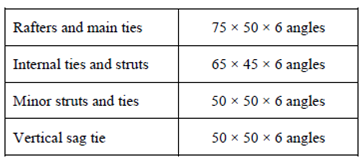Design of Truss Members:
As the truss is supposed to be loaded at their joints, and the joints are assumed to be pin-jointed, there will be no bending within the members and they shall be subjected to either tensile or compressive forces only. Usually, the forces in the members may be so small as to indicate very small angle sections. Therefore, from the point of view of truss-stiffness and also to resist transport and erection stresses, the following minimum sections are recommended.

Sometimes when the main rafters carry an intermediate purlin (placed in among two node points) it may be subjected to bending moments in addition to compressive forces, therefore a double-angle section may be required. This happens when the spacing among the nodes is too large (greater than 1.6 m say).